Impact of Land-Use Change on Ecosystem Services in the Wuling Mountains from a Transport Development Perspective
Abstract
1. Introduction
2. Materials and Methods
2.1. Study Area
2.2. Data Sources
2.3. Research Methods
2.3.1. Land-Use Change Measurement
2.3.2. ESV Calculation
2.3.3. Kernel Density Analysis
2.3.4. Hot Spot Analysis
3. Results
3.1. Development of Transport Pattern in Wuling Mountains
- (1)
- Traditional transportation period (2000–2005). At the beginning of the 21st century, the Wuling Mountain area was still in the traditional traffic period. The city of Huaihua became the center of the Wuling Mountains because it was at the crossroads of two major railways and National Roads 209 and 320. Jishou and Zhangjiajie, on the Zhiliu railway, have become the capitals of their respective municipalities. Additionally, Enshi, a city in which National Road 318 and 209 meet, has become the central city in the western Hubei region. In the traditional transportation period, the Wuling Mountains formed a regional location pattern with Huaihua as the main center and Jishou, Zhangjiajie, and Enshi as regional subcenters (Figure 2).
- (2)
- Early period of highways (2005–2010). After 2005, highways were constructed in the Wuling Mountains. From 2005 to 2010, the first highways were constructed in Huaihua (G60, Shanghai–Kunming Highway), Jishou (G56, Hang–Rui Highway), Zhangjiajie (G5513, Chang–Zhang Highway), and Enshi (G50, Hu–Yu Highway), representing the centers of the four east–west horizontal routes (Figure 2).
- (3)
- Network period of highways (2010–2015). After 2010, the Baomao Highway G65 connected Jishou and Huaihua to the route from the eastern part of Chongqing while G56 further connected the route from the northeastern part of Qianhai to Zunyi to the west. At this point, the western part of the Wuling Mountains was connected to the national motorway network. The route from Loudi to Huaihua was added to the southeast. Vertical routes also started to develop. The north–south axis of Ensh–Lefeng–Jishou–Huaihua runs through the Wuling Mountains (G6911); highways to the northeast of Qianjiang, from Ensh to Qianjiang, and from Qianjiang to Tongren, were gradually built. By 2015, the entire Wuling Mountains region formed a motorway network with Enshi, Zhangjiajie, Jishou, and Huaihua as the central axis running north–south and connecting major node cities from east to west (Figure 2).
- (4)
- High-speed railway period (2015–2020). After 2015, high-speed railways first connected Huaihua, Jishou, Zhangjiajie, and Enshi, whereas motorways further penetrated the remaining counties. The establishment of the Zhangjihuai, Shanghai-Kunming, and Shanghai–Hanrong high-speed railways led to a new development pattern in the Wuling Mountains region. Four major node cities were connected to the national rapid transport network through high-speed railways and their urban development further strengthened; counties also developed after being connected to the network through highways (Figure 2).
3.2. Land-Use Change and General ESV Changes in the Wuling Mountains
3.3. Analysis of Spatiotemporal Variation in Land-Use Change in the Wuling Mountains from a Traffic Pattern Perspective
3.3.1. Spatiotemporal Characteristics of Land-Use Change during Different Periods of Transport Development
- (1)
- Traditional transportation period (2000–2005)
- (2)
- Early period of highways (2005–2010)
- (3)
- Network period of highways (2010–2015)
- (4)
- High-speed railway period (2015–2020)
3.3.2. Analysis of Spatiotemporal Variation in Kernel Density of Each Land-Use Change
3.4. Effect of Land-Use Change on Changes in ESV in Wuling Mountains
3.4.1. Spatiotemporal Variation in ESV in Different Periods of Transport Development
- (1)
- Traditional transportation period (2000–2005)
- (2)
- Early highway period (2005–2010a)
- (3)
- Network period of highways (2010–2015)
- (4)
- High-speed railway period (2015–2020)
3.4.2. Hot-Spot Analysis of ESV Changes
- (1)
- The cold-spot area, in which the ESV reduction value was always concentrated, showed a notable correlation with traffic; it was distributed in the vicinity of the main traffic arteries in each period. When traffic was used as the axis, a “point–line–network–pole” trend could be observed. From 2000 to 2005, cold spots were scattered around the hub cities of traditional railway lines (e.g., Huaihua, Loudi, Jishou, and Cili) in the form of dots. From 2005 to 2010, with the construction of the four highways, the cold-spot area was primarily distributed around the highways. Overall, the cold-spot cluster area presented four horizontal linear spatial patterns. From 2010 to 2015, the highways were further connected to form a network; the cold spot cluster area showed a spatial network pattern. From 2015 to 2020, the decreased growth of construction land led to a decrease in cold spots compared with the previous period. However, owing to the establishment of the high-speed railway, the surrounding hub cities along the line (e.g., Huaihua, Jishou, Shaoyang, and Tongren) were still the main areas of cold-spot agglomeration. The overall form of the cold-spot agglomeration area showed a polarized spatial pattern (Figure 8).
- (2)
- Hot-spot areas of ESV value-added clustering were more related to geographical location factors. The areas surrounding the Yangtze River have always been the key areas for hot-spot clustering. The Wuling Mountains are located in the middle and upper reaches of the Yangtze River; Hubei, Chongqing, and Guizhou are adjacent to the Yangtze River. After the 1998 Yangtze River flood, large-scale ecological restoration projects were carried out along the Yangtze River Basin to return farmland to forests and lakes. Additionally, the Three Gorges Project represents the rapid development of water conservancy projects in the past 20 years. With these two policy backgrounds, the Yangtze River has become an ESV hot spot. According to the implementation of policy phases, the temporal sequence of the hot-spot area range showed a “large-scale expansion–small-scale concentration–shrinkage–repeated expansion” pattern (Figure 8).
4. Discussion and Insights
4.1. Effect of Land-Use Change on ESV from a Transport Pattern Perspective
4.2. Policy Applications
4.2.1. Transportation and Land Use Optimization
4.2.2. Sustainable Development
4.3. Limitations
5. Conclusions
- (1)
- Since the 21st century, in five-year increments, the development of transportation in the Wuling Mountain areas has roughly experienced four stages: the traditional transportation period, early expressway development, expressway networking period, and high-speed railway period.
- (2)
- The development of construction land and gardens first declined rapidly, then increased, and finally declined slightly. Forestland and water bodies have experienced rapid development, weakening, slowing, and finally more rapid development. In terms of spatially divergent characteristics, the development of transport has had a significant effect on construction land and indirectly affects land for economic crops (garden). The spatial pattern of construction land growth has evolved along with transport development in a “point–line–network–pole” process. Gardens have also gradually spread from the better-connected southeastern region to the entire region. In contrast, forestland has been influenced by the policies of returning farmland to forestry and ecological civilization. It has significantly expanded from the Yangtze River coastal area, then shrank, and then gradually spread across the entire region.
- (3)
- In response, the ESV increased, decreased, significantly declined, and then the decline slowed over the past 20 years. In terms of spatial pattern changes, the periphery of the transportation axis has formed a cluster of ESV cold spots. The spatial pattern also showed “point–line–network–pole” evolution characteristics due to the development of transportation. In contrast, ESV hot spots were more concentrated in areas along the Yangtze River. The regional scope showed “large scale expansion–small scale concentration–shrinkage–repeated expansion”.
Author Contributions
Funding
Institutional Review Board Statement
Informed Consent Statement
Data Availability Statement
Conflicts of Interest
References
- Cervero, R.B. Linking urban transport and land use in developing countries. J. Transp. Land Use 2013, 6, 7–24. [Google Scholar] [CrossRef]
- Liu, Y.; Wang, F.; Xiao, Y.; Gao, S. Urban land uses and traffic ‘source-sink areas’: Evidence from GPS-enabled taxi data in Shanghai. Landsc. Urban Plan. 2012, 106, 73–87. [Google Scholar] [CrossRef]
- Yang, S.Q.; Zhu, G.R.; Liu, J.; Xu, H.L. The research progress of the traffic ecological effects under the perspective of “Pattern-Process-Function”. Ecol. Environ. Sci. 2022, 31, 634–642. (In Chinese) [Google Scholar]
- Wagner, T. Regional traffic impacts of logistics-related land use. Transp. Policy 2010, 17, 224–229. [Google Scholar] [CrossRef]
- Shen, T.; Hong, Y.; Thompson, M.M.; Liu, J.; Huo, X.; Wu, L. How does parking availability interplay with the land use and affect traffic congestion in urban areas? The case study of Xi’an, China. Sustain. Cities Soc. 2020, 57, 102126. [Google Scholar] [CrossRef]
- Yu, T.; Bao, A.M.; Liu, T.; Guo, H.; Zheng, G.X.; Chen, T. Effects of different level roads on land use and landscape pattern of Manas River Basin. J. Nat. Resour. 2019, 34, 2427–2439. (In Chinese) [Google Scholar]
- Wang, Y.; Dai, E.; Yin, L.; Ma, L. Land use/land cover change and the effects on ecosystem services in the Hengduan Mountain region, China. Ecosyst. Serv. 2018, 34, 55–67. [Google Scholar] [CrossRef]
- Wu, X.; Wang, S.; Fu, B.; Liu, Y.; Zhu, Y. Land use optimization based on ecosystem service assessment: A case study in the Yanhe watershed. Land Use Policy 2018, 72, 303–312. [Google Scholar] [CrossRef]
- Xue, M.; Luo, Y. Dynamic variations in ecosystem service value and sustainability of urban system: A case study for Tianjin city, China. Cities 2015, 46, 85–93. [Google Scholar] [CrossRef]
- Zhang, S.; Ramírez, F.M. Assessing and mapping ecosystem services to support urban green infrastructure: The case of Barcelona, Spain. Cities 2019, 92, 59–70. [Google Scholar] [CrossRef]
- Wang, J.; Chen, Y.; Shao, X.; Zhang, Y.; Cao, Y. Land-use changes and policy dimension driving forces in China: Present, trend and future. Land Use Policy 2012, 29, 737–749. [Google Scholar] [CrossRef]
- Różański, S.; Jaworska, H.; Matuszczak, K.; Nowak, J.; Hardy, A. Impact of highway traffic and the acoustic screen on the content and spatial distribution of heavy metals in soils. Environ. Sci. Pollut. Res. 2017, 24, 12778–12786. [Google Scholar] [CrossRef] [PubMed]
- Chen, W.; Zeng, Y.; Zeng, J. Impacts of traffic accessibility on ecosystem services: An integrated spatial approach. J. Geogr. Sci. 2021, 31, 1816–1836. [Google Scholar] [CrossRef]
- Chen, W.; Chi, G.; Li, J. Ecosystem Services and Their Driving Forces in the Middle Reaches of the Yangtze River Urban Agglomerations, China. Int. J. Environ. Res. Public Health 2020, 17, 3717. [Google Scholar] [CrossRef]
- Li, Y.; Xiao, L.M.; Hu, W.M.; Yi, M.; Xie, Y.Z. Spatiotemporal Pattern of Land Use Change in Changsha-Zhuzhou-Xiangtan Core Areas and Its Driving Forces. Econ. Geogr. 2021, 41, 173–182. (In Chinese) [Google Scholar]
- Aljoufie, M.; Zuidgeest, M.; Brussel, M.; van Maarseveen, M. Spatial-temporal analysis of urban growth and transportation in Jeddah City, Saudi Arabia. CITIES 2013, 31, 57–68. [Google Scholar] [CrossRef]
- Cilliers, S.; Siebert, S.; Du Toit, M.; Barthel, S.; Mishra, S.; Cornelius, S.; Davoren, E. Garden ecosystem services of Sub-Saharan Africa and the role of health clinic gardens as social-ecological systems. Landsc. Urban Plan. 2018, 180, 294–307. [Google Scholar] [CrossRef]
- Liang, X.; Li, Y.; Shao, J.; Ran, C. Traditional agroecosystem transition in mountainous area of Three Gorges Reservoir Area. J. Geogr. Sci. 2020, 30, 281–296. [Google Scholar] [CrossRef]
- Xiong, Y.F.; Zhang, A.L.; Liu, M.B.; Li, H. Effects of citrus orchard expansion on ecosystem services and landscape pattern:A case study of Xinfeng County, Jiangxi Province, China. Acta Ecol. Sin. 2022, 42, 7845–7857. (In Chinese) [Google Scholar]
- Liang, J.; Li, S.; Li, X.; Li, X.; Liu, Q.; Meng, Q.; Lin, A.; Li, J. Trade-off analyses and optimization of water-related ecosystem services (WRESs) based on land use change in a typical agricultural watershed, southern China. J. Clean. Prod. 2020, 279, 123851. [Google Scholar] [CrossRef]
- Wästfelt, A.; Zhang, Q. Reclaiming localisation for revitalising agriculture: A case study of peri-urban agricultural change in Gothenburg, Sweden. J. Rural. Stud. 2016, 47, 172–185. [Google Scholar] [CrossRef]
- Comberti, C.; Thornton, T.; de Echeverria, V.W.; Patterson, T. Ecosystem services or services to ecosystems? Valuing cultivation and reciprocal relationships between humans and ecosystems. Glob. Environ. Chang. 2015, 34, 247–262. [Google Scholar] [CrossRef]
- Solomon, N.; Segnon, A.C.; Birhane, E. Ecosystem Service Values Changes in Response to Land-Use/Land-Cover Dynamics in Dry Afromontane Forest in Northern Ethiopia. Int. J. Environ. Res. Public Health 2019, 16, 4653. [Google Scholar] [CrossRef] [PubMed]
- Costanza, R.; de Groot, R.; Sutton, P.; Faeber, S. The value of the world’s ecosystem services and natural capital. Nature 1997, 387, 253–260. [Google Scholar] [CrossRef]
- Costanza, R. Ecosystem services: Multiple classification systems are needed. Biol. Conserv. 2008, 141, 350–352. [Google Scholar] [CrossRef]
- Costanza, R.; de Groot, R.; Sutton, P.; van der Ploeg, S.; Anderson, S.J.; Kubiszewski, I.; Farber, S.; Turner, R.K. Changes in the global value of ecosystem services. Glob. Environ. Chang.-Hum. Policy Dimens. 2014, 26, 152–158. [Google Scholar] [CrossRef]
- De Groot, R.; Brander, L.; Van Der Ploeg, S.; Costanza, R.; Bernard, F.; Braat, L.; Christie, M.; Crossman, N.; Ghermandi, A.; Hein, L.; et al. Global estimates of the value of ecosystems and their services in monetary units. Ecosyst. Serv. 2012, 1, 50–61. [Google Scholar] [CrossRef]
- Xie, G.D.; Zhen, L.; Lu, C.X.; Xiao, Y.; Chen, C. Expert knowledge based valuation method of ecosystem services in China. J. Nat. Resour. 2008, 23, 911–919. (In Chinese) [Google Scholar]
- Chuai, X.; Wen, J.; Zhuang, D.; Guo, X.; Yuan, Y.; Lu, Y.; Zhang, M.; Li, J. Intersection of Physical and Anthropogenic Effects on Land-Use/Land-Cover Changes in Coastal China of Jiangsu Province. Sustainability 2019, 11, 2370. [Google Scholar] [CrossRef]
- Meyfroid, P.; Chowdhury, R.R.; de Bremond, A.; Ellis, E.C.; Erb, K.H.; Filatova, T.; Garrett, R.D.; Grove, J.M.; Heinimann, A.; Kuemmerle, T.; et al. Middle-range theories of land system change. Glob. Environ. Chang.-Hum. Policy Dimens. 2018, 53, 52–67. [Google Scholar] [CrossRef]
- Fu, B.J.; Zhang, L.W. Land-use change and ecosystem services:concepts, methods and proress. Prog. Geogr. 2014, 33, 441–446. (In Chinese) [Google Scholar]
- Fu, B. Ecological and environmental effects of land-use changes in the Loess Plateau of China. Chin. Sci. Bull. 2022, 67, 3769–3779. [Google Scholar] [CrossRef]
- Tolessa, T.; Senbeta, F.; Kidane, M. The impact of land use/land cover change on ecosystem services in the central highlands of Ethiopia. Ecosyst. Serv. 2017, 23, 47–54. [Google Scholar] [CrossRef]
- Schirpke, U.; Kohler, M.; Leitinger, G.; Fontana, V.; Tasser, E.; Tappeiner, U. Future impacts of changing land-use and climate on ecosystem services of mountain grassland and their resilience. Ecosyst. Serv. 2017, 26, 79–94. [Google Scholar] [CrossRef]
- Rimal, B.; Sharma, R.; Kunwar, R.; Keshtkar, H.; Stork, N.E.; Rijal, S.; Rahman, S.A.; Baral, H. Effects of land use and land cover change on ecosystem services in the Koshi River Basin, Eastern Nepal. Ecosyst. Serv. 2019, 38, 100963. [Google Scholar] [CrossRef]
- Qi, Y.; Lian, X.; Wang, H.; Zhang, J.; Yang, R. Dynamic mechanism between human activities and ecosystem services: A case study of Qinghai lake watershed, China. Ecol. Indic. 2020, 117, 106528. [Google Scholar] [CrossRef]
- Lyu, R.; Zhang, J.; Xu, M.; Li, J. Impacts of urbanization on ecosystem services and their temporal relations: A case study in Northern Ningxia, China. Land Use Policy 2018, 77, 163–173. [Google Scholar] [CrossRef]
- Luo, D.; Zhang, W. A comparison of Markov model-based methods for predicting the ecosystem service value of land use in Wuhan, central China. Ecosyst. Serv. 2014, 7, 57–65. [Google Scholar] [CrossRef]
- Li, F.; Ye, Y.P.; Song, B.W.; Wang, R.S.; Tao, Y. Assessing the changes in land use and ecosystem services in Changzhou municipality, Peoples’ Republic of China, 1991–2006. Ecol. Indic. 2014, 42, 95–103. [Google Scholar] [CrossRef]
- Xiao, R.; Lin, M.; Fei, X.; Li, Y.; Zhang, Z.; Meng, Q. Exploring the interactive coercing relationship between urbanization and ecosystem service value in the Shanghai–Hangzhou Bay Metropolitan Region. J. Clean. Prod. 2019, 253, 119803. [Google Scholar] [CrossRef]
- Ye, Y.; Zhang, J.; Wang, T.; Bai, H.; Wang, X.; Zhao, W. Changes in Land-Use and Ecosystem Service Value in Guangdong Province, Southern China, from 1990 to 2018. Land 2021, 10, 426. [Google Scholar] [CrossRef]
- Gao, J.; Li, F.; Gao, H.; Zhou, C.; Zhang, X. The impact of land-use change on water-related ecosystem services: A study of the Guishui River Basin, Beijing, China. J. Clean. Prod. 2017, 163, S148–S155. [Google Scholar] [CrossRef]
- Wu, J.; Jin, X.; Feng, Z.; Chen, T.; Wang, C.; Feng, D.; Lv, J. Relationship of Ecosystem Services in the Beijing–Tianjin–Hebei Region Based on the Production Possibility Frontier. Land 2021, 10, 881. [Google Scholar] [CrossRef]
- Zhu, H.Y.; Li, X.B. Discussion on the Index Method of Regional Land Use Change. Acta. Geogr. Sin. 2003, 58, 643–650. (In Chinese) [Google Scholar]
- Xie, G.D.; Zhang, C.X.; Zhang, L.M.; Chen, W.H.; Li, S.M. Improvement of the Evaluation Method for Ecosystem Service Value Based on Per Unit Area. J. Nat. Resour. 2015, 30, 1243–1254. (In Chinese) [Google Scholar]
- Xie, G.D.; Lu, C.X.; Leng, Y.F.; Zheng, D.; Li, S.C. Ecological assets valuation of the Tibetan Plateau. J. Nat. Resour. 2003, 18, 189–196. (In Chinese) [Google Scholar]
- Guo, C.Y.; Gao, S.; Zhou, B.Y.; Gao, J.H. Effects of land use change on ecosystem service value in Funiu Mountain based upon a grid square. Acta. Ecol. Sin. 2019, 39, 3482–3493. (In Chinese) [Google Scholar]
- Wang, H.C.; Xu, H. Shanghai urban-rural ecotone distribution research based on the POI and kernel density analysis. J. Shanghai Jiaotong Univ. (Agric. Sci.) 2019, 37, 1–5+18. (In Chinese) [Google Scholar]
- Lefebvre, H. La Production de L’espace; Éditions Anthropos: París, France, 1974; 596p. [Google Scholar]
- Shi, J.; He, C.F. Research progress in spatial dynamics of firms. Prog. Geogr. 2014, 33, 1342–1353. (In Chinese) [Google Scholar]
- Jin, Y.; Denman, S.; Deng, D.; Rong, X.; Ma, M.; Wan, L.; Mao, Q.; Zhao, L.; Long, Y. Environmental impacts of transformative land use and transport developments in the Greater Beijing Region: Insights from a new dynamic spatial equilibrium model. Transp. Res. Part D Transp. Environ. 2017, 52, 548–561. [Google Scholar] [CrossRef]
- Yigitcanlar, T.; Kamruzzaman, M. Investigating the interplay between transport, land use and the environment: A review of the literature. Int. J. Environ. Sci. Technol. 2014, 11, 2121–2132. [Google Scholar] [CrossRef]
- Velaga, N.; Nelson, J.; Wright, S.; Farrington, J. The Potential Role of Flexible Transport Services in Enhancing Rural Public Transport Provision. J. Public Transp. 2012, 15, 111–131. [Google Scholar] [CrossRef]
- Wang, P.F.; Xu, W.P. Study on land use at micro level: A case study of Donglaozhuang village, Shandong province. Geogr. Res. 2015, 34, 1088–1096. (In Chinese) [Google Scholar]
- Zhu, W.Z.; Du, P.P.; Wu, N.L.; Li, X.J. Location of vegetable cultivation in traditional rural areas: A case study of Kaifeng, Henan province. Hum. Geogr. 2015, 30, 89–96. (In Chinese) [Google Scholar]
- Chen, Y.; Li, J.F.; Xu, J. The impact of socio-economic factors on ecological service value in Hubei province: A geographically weighted regression approach. China Land Sci. 2015, 29, 89–96. (In Chinese) [Google Scholar]
- Wang, Z.L. A Study on the Layout, Morphology and Functional Structure of Cities in the Ethnic Areas of Wuling Mountains in Modern Times. Urban Hist. Res. 2016, 2, 140–153+241. (In Chinese) [Google Scholar]
- Ouyang, Z.Y.; Zheng, H.; Yue, P. Establishment of ecological compensation mechanisms in China: Perspectives and strategies. Acta Ecol. Sin. 2013, 33, 686–692. (In Chinese) [Google Scholar] [CrossRef]

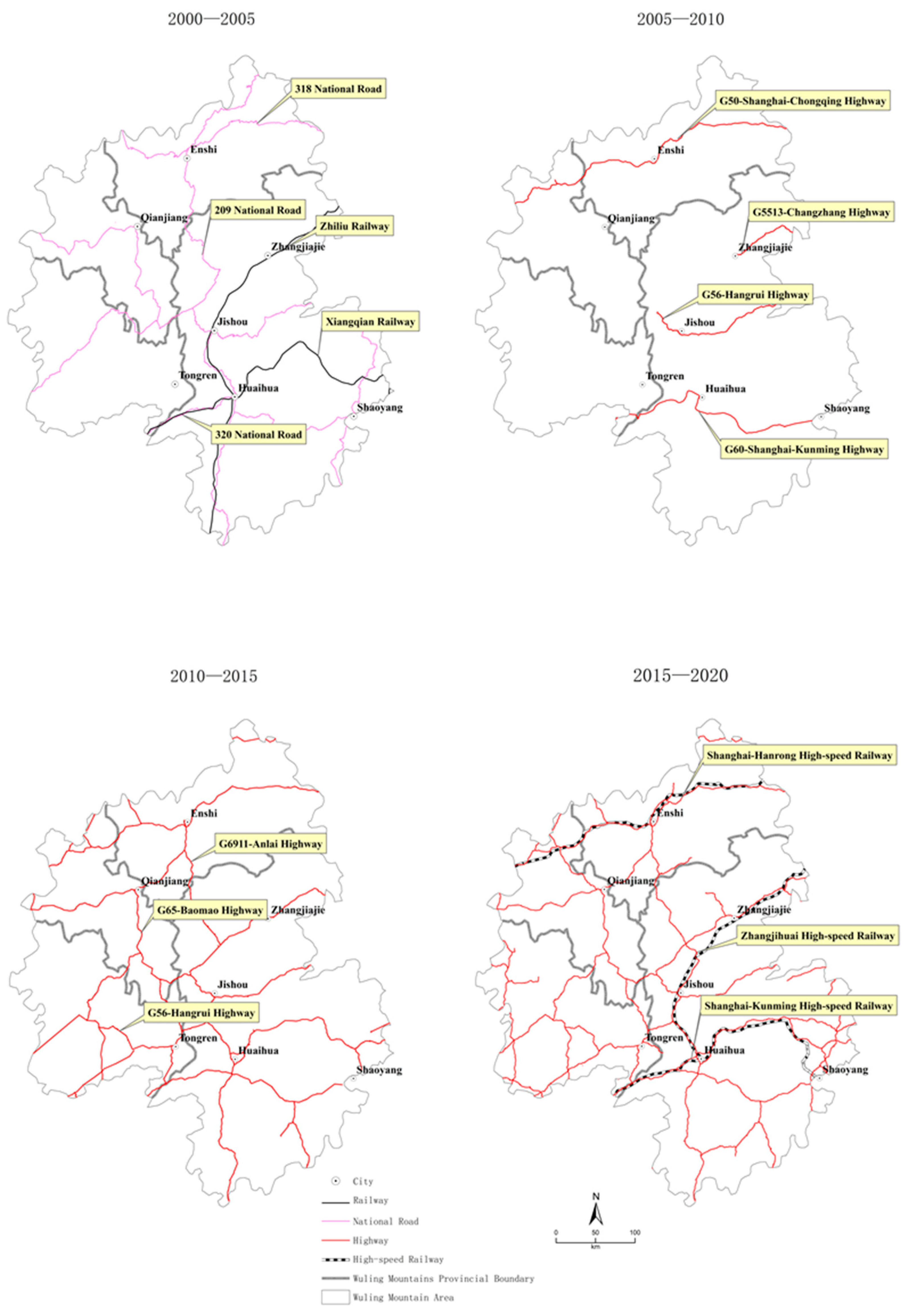

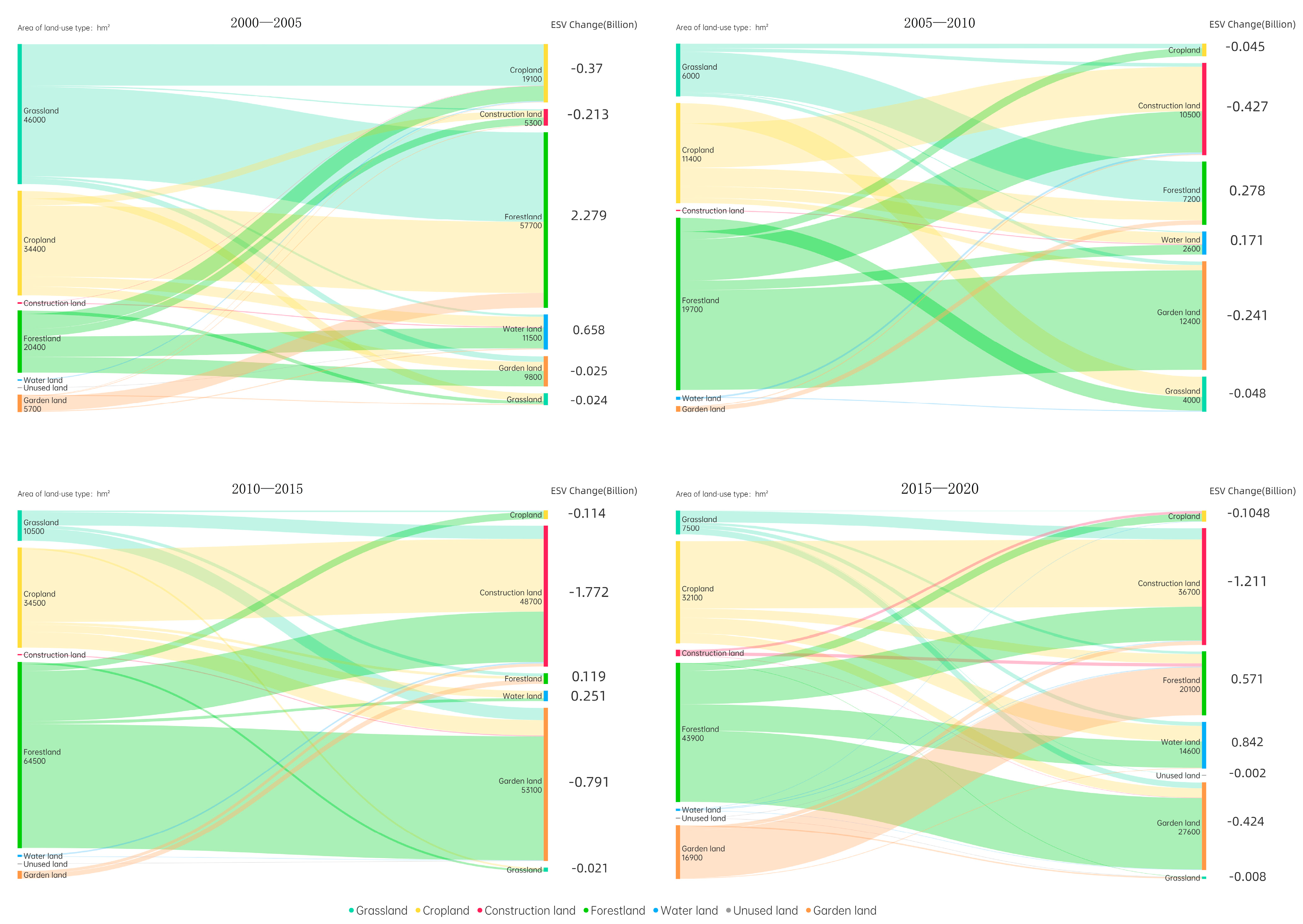

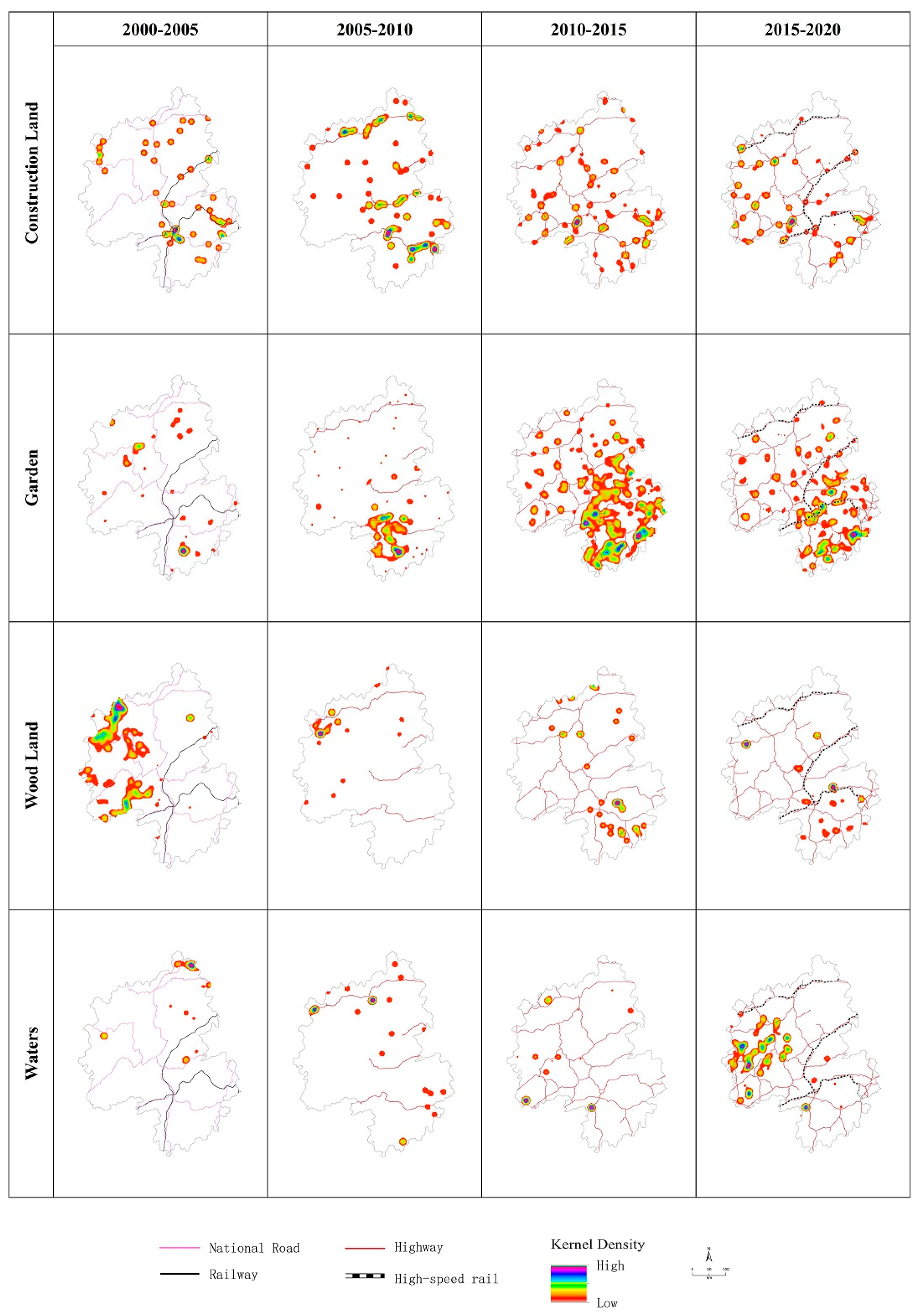
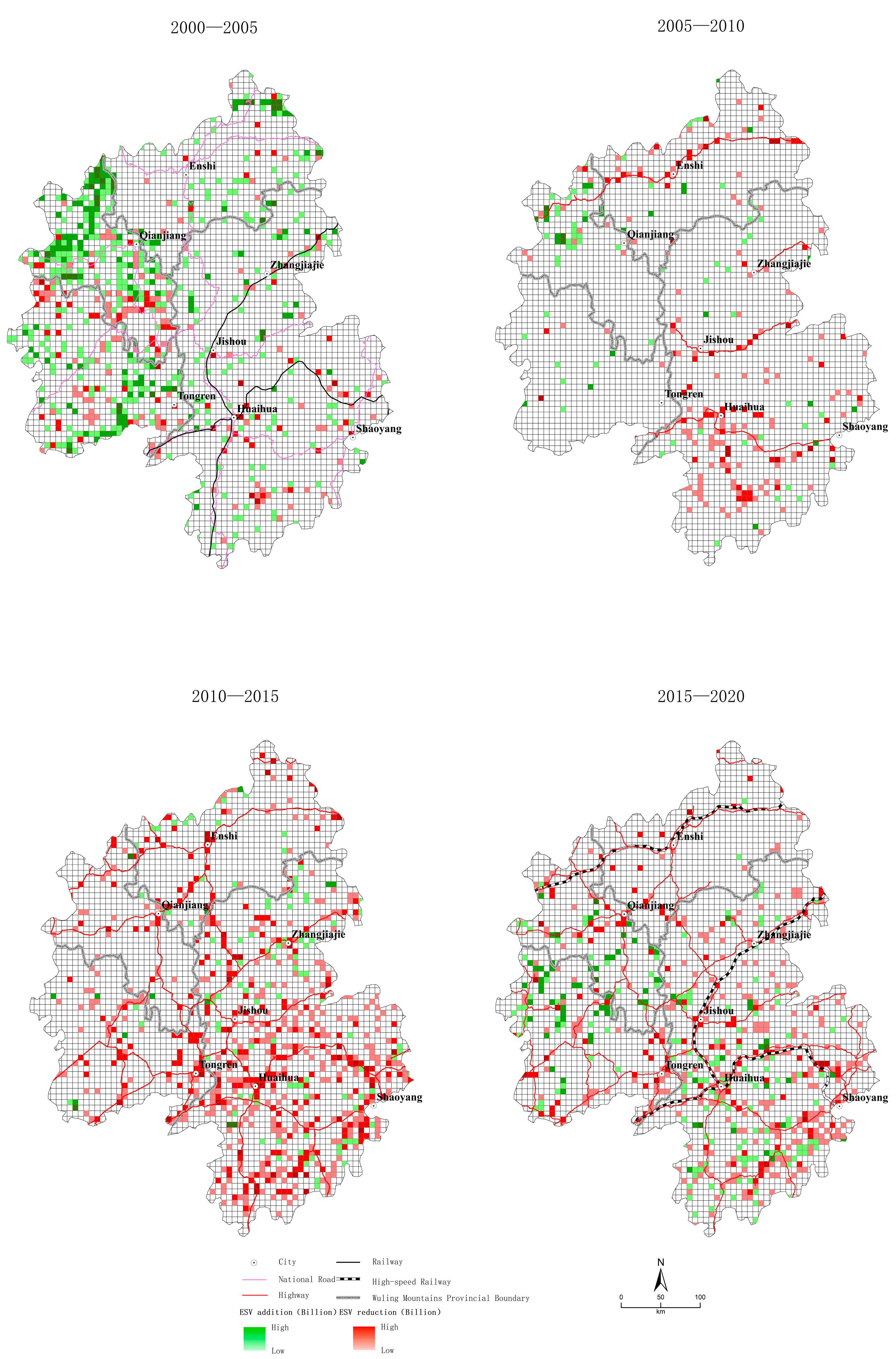
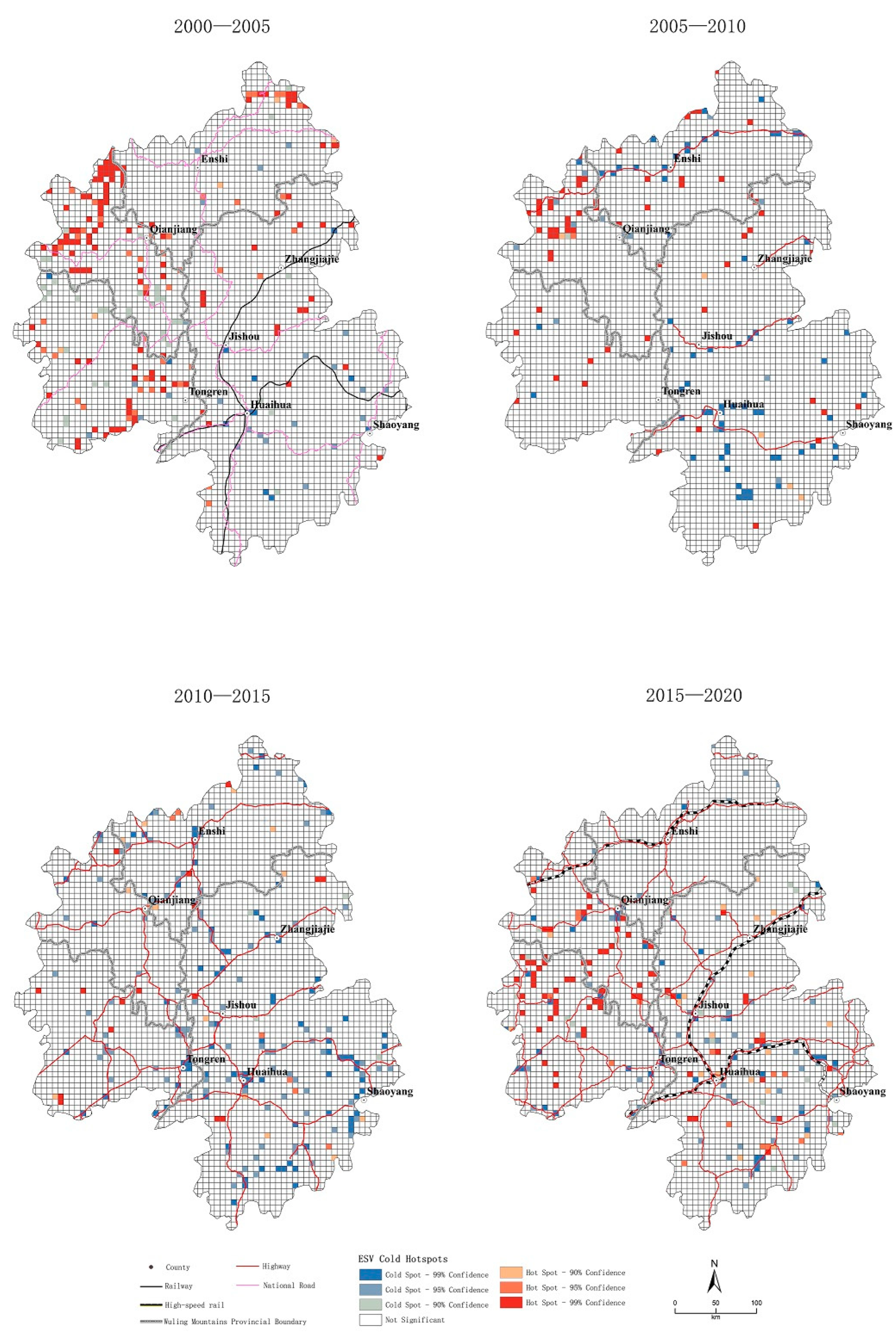
| The First Category | The Second Category | Grassland | Cropland | Construction Land | Forestland | Water Land | Unused Land | Garden |
|---|---|---|---|---|---|---|---|---|
| Provisioning service | Food production | 973.3 | 2263.4 | 0.0 | 746.9 | 1199.6 | 45.3 | 1516.5 |
| Raw material produce | 814.8 | 882.7 | 0.0 | 6744.8 | 792.2 | 90.5 | 3825.1 | |
| Regulating service | Gas regulation | 3395.1 | 1629.6 | 0.0 | 9777.8 | 1154.3 | 135.8 | 5703.7 |
| Climate regulation | 3530.9 | 2195.5 | 0.0 | 9211.9 | 4662.5 | 294.2 | 5703.7 | |
| Hydrological regulation | 3440.3 | 1742.8 | 0.0 | 9257.2 | 42,483.5 | 158.4 | 5500.0 | |
| Waste disposal | 2987.7 | 3146.1 | 0.0 | 3893.0 | 33,611.0 | 588.5 | 3530.9 | |
| Supporting service | Soil conservation | 5070.0 | 3327.2 | 0.0 | 9098.8 | 928.0 | 384.8 | 6224.3 |
| Biodiversity | 4232.5 | 2308.6 | 0.0 | 10,207.8 | 7763.4 | 905.4 | 6269.5 | |
| Cultural service | Providing aesthetic Landscape | 1969.1 | 384.8 | 0.0 | 4707.8 | 10,049.4 | 543.2 | 2557.6 |
| A total of (Yuan/hm2) | 26,413.5 | 17,880.6 | 0.0 | 63,646.0 | 102,643.8 | 3146.1 | 40,763.3 | |
Disclaimer/Publisher’s Note: The statements, opinions and data contained in all publications are solely those of the individual author(s) and contributor(s) and not of MDPI and/or the editor(s). MDPI and/or the editor(s) disclaim responsibility for any injury to people or property resulting from any ideas, methods, instructions or products referred to in the content. |
© 2023 by the authors. Licensee MDPI, Basel, Switzerland. This article is an open access article distributed under the terms and conditions of the Creative Commons Attribution (CC BY) license (https://creativecommons.org/licenses/by/4.0/).
Share and Cite
Chen, Y.; Liu, Y.; Yang, S.; Liu, C. Impact of Land-Use Change on Ecosystem Services in the Wuling Mountains from a Transport Development Perspective. Int. J. Environ. Res. Public Health 2023, 20, 1323. https://doi.org/10.3390/ijerph20021323
Chen Y, Liu Y, Yang S, Liu C. Impact of Land-Use Change on Ecosystem Services in the Wuling Mountains from a Transport Development Perspective. International Journal of Environmental Research and Public Health. 2023; 20(2):1323. https://doi.org/10.3390/ijerph20021323
Chicago/Turabian StyleChen, Yu, Yilian Liu, Shengfu Yang, and Chengwu Liu. 2023. "Impact of Land-Use Change on Ecosystem Services in the Wuling Mountains from a Transport Development Perspective" International Journal of Environmental Research and Public Health 20, no. 2: 1323. https://doi.org/10.3390/ijerph20021323
APA StyleChen, Y., Liu, Y., Yang, S., & Liu, C. (2023). Impact of Land-Use Change on Ecosystem Services in the Wuling Mountains from a Transport Development Perspective. International Journal of Environmental Research and Public Health, 20(2), 1323. https://doi.org/10.3390/ijerph20021323





